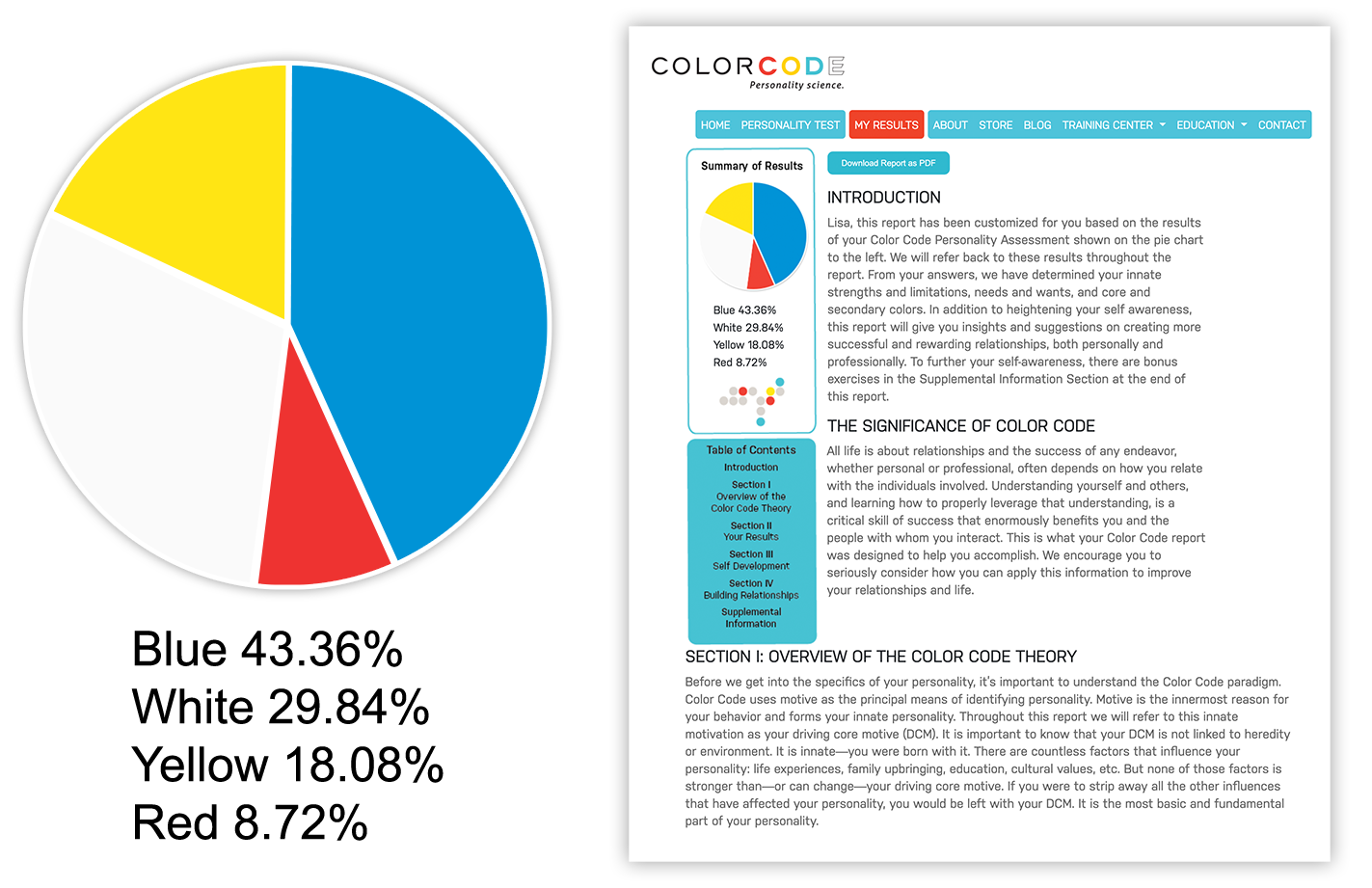Indirect Communicator is a LIMITATION of the WHITE personality in the Color Code Personality Assessment.
Indirect Communicator
"Communicate. Even when it's uncomfortable or uneasy. One of the best ways to heal, is simply getting everything out."― Anonymous
Lisa Ulshafer /  Are you someone who avoids direct communication with others? Do you struggle to express your thoughts and feelings in a clear and concise manner? Indirect communication refers to a style of communication where you tend to express your thoughts, feelings, and needs indirectly, often through hints, suggestions, or non-verbal cues, rather than being direct and explicit in your communication. This style of communication can be influenced by cultural, social, and personal factors, and can have both advantages and disadvantages in various situations. Understanding the dynamics of indirect communication can be helpful in navigating different interpersonal interactions and contexts, and developing effective communication skills.
Are you someone who avoids direct communication with others? Do you struggle to express your thoughts and feelings in a clear and concise manner? Indirect communication refers to a style of communication where you tend to express your thoughts, feelings, and needs indirectly, often through hints, suggestions, or non-verbal cues, rather than being direct and explicit in your communication. This style of communication can be influenced by cultural, social, and personal factors, and can have both advantages and disadvantages in various situations. Understanding the dynamics of indirect communication can be helpful in navigating different interpersonal interactions and contexts, and developing effective communication skills.
Here are some common signs that you may be an indirect communicator:
-
Use of hints or suggestions instead of direct statements: You find yourself using subtle hints or suggestions to convey your thoughts, feelings, or needs instead of expressing them directly and explicitly.
-
Reluctance to express opinions or assert oneself: You often hesitate to express your opinions, assert your needs or preferences, or speak up for yourself, and instead rely on subtle cues or indirect methods to communicate your thoughts or needs.
-
Difficulty in saying "no" directly: You find it challenging to say "no" directly and often resort to evasiveness or avoidance to decline requests or invitations.
-
Relying on non-verbal cues: You heavily rely on non-verbal cues, such as body language, facial expressions, or gestures, to communicate your thoughts or emotions, and avoid direct verbal communication.
-
Fear of confrontation or conflict: You tend to avoid confrontation or conflict and opt for indirect communication methods to avoid disagreements or uncomfortable situations.
-
Difficulty in expressing emotions openly: You find it challenging to express your emotions directly and instead use subtle cues or hints to convey your feelings.
-
Reliance on intermediaries: You often rely on intermediaries or go-betweens to communicate your thoughts, needs, or concerns to others, rather than directly addressing the person involved.
-
Tendency to beat around the bush: You tend to beat around the bush instead of being direct and concise in your communication.
-
Difficulty in initiating difficult conversations: You find it challenging to initiate difficult conversations or address sensitive topics directly and instead use indirect methods to communicate your concerns or opinions.
-
Misinterpretation of indirect cues: You often misinterpret or have difficulty understanding indirect cues or hints from others, or you find it challenging to interpret the intended meaning behind indirect communication.
Here are 10 strategies for overcoming being an indirect communicator:
-
Practice assertive communication: Learn and practice assertive communication techniques that allow you to express your thoughts, feelings, needs, and opinions directly, clearly, and respectfully. This may involve using "I" statements, expressing your opinions and needs in a confident and straightforward manner, and being assertive but not aggressive.
-
Increase self-awareness: Reflect on your communication style and patterns, and identify situations or triggers that lead you to be indirect in your communication. Understanding your communication tendencies can help you become more conscious of when you are being indirect and make efforts to change them.
-
Enhance communication skills: Work on improving your overall communication skills, including listening actively, expressing yourself clearly, and asking clarifying questions when needed. Developing effective communication skills can help you communicate more directly and confidently.
-
Build self-confidence: Strengthen your self-confidence and self-esteem, as being indirect in communication can often be linked to a lack of confidence in expressing oneself directly. Practice self-affirmation, self-compassion, and assertiveness to build your confidence in expressing your thoughts and needs directly.
-
Be mindful of non-verbal cues: Pay attention to your non-verbal cues, such as body language, facial expressions, and gestures, and ensure that they align with your verbal communication. Being aware of your non-verbal cues can help you communicate more clearly and directly.
-
Learn to say "no" directly: Practice saying "no" directly and respectfully when needed, without resorting to evasion or avoidance. Remember that it's okay to say "no" and express your boundaries directly and assertively.
-
Practice open and honest communication: Foster an environment of open and honest communication in your interactions with others. Encourage direct and clear communication, and lead by example by being open and honest in your own communication.
-
Seek feedback from others: Ask for feedback from trusted friends, family members, or colleagues about your communication style, and be open to receiving constructive criticism. Use the feedback to identify areas where you can improve your direct communication skills.
-
Practice active listening: Listen actively to others, and make efforts to understand their messages without assuming or interpreting indirect cues. Clarify and confirm your understanding by asking questions or paraphrasing to ensure accurate communication.
-
Practice in low-stakes situations: Start practicing direct communication in low-stakes situations where the outcome is not critical, such as with friends, family members, or supportive colleagues. This can help you build confidence in being more direct in your communication style before applying it to more challenging situations.
Overcoming being an indirect communicator can lead to greater clarity, understanding, and healthier relationships. Direct communication involves expressing yourself honestly, openly, and assertively, while actively listening to others with an open mind. It can prevent misunderstandings, miscommunications, and unnecessary conflicts. With direct communication, you can express their thoughts, feelings, and needs more effectively, leading to improved relationships with loved ones, colleagues, and friends. It allows for open and authentic conversations, where opinions and perspectives can be shared without fear of misinterpretation or miscommunication. Direct communication can involve setting clear boundaries, expressing yourself with confidence, and actively seeking feedback and input from others. It can lead to improved problem-solving, conflict resolution, and overall interpersonal effectiveness. By cultivating direct communication, you can foster healthier relationships, avoid misunderstandings, and create a more harmonious and fulfilling social environment where open and honest communication is valued.
Indirect Communicator
― Anonymous
 Are you someone who avoids direct communication with others? Do you struggle to express your thoughts and feelings in a clear and concise manner? Indirect communication refers to a style of communication where you tend to express your thoughts, feelings, and needs indirectly, often through hints, suggestions, or non-verbal cues, rather than being direct and explicit in your communication. This style of communication can be influenced by cultural, social, and personal factors, and can have both advantages and disadvantages in various situations. Understanding the dynamics of indirect communication can be helpful in navigating different interpersonal interactions and contexts, and developing effective communication skills.
Are you someone who avoids direct communication with others? Do you struggle to express your thoughts and feelings in a clear and concise manner? Indirect communication refers to a style of communication where you tend to express your thoughts, feelings, and needs indirectly, often through hints, suggestions, or non-verbal cues, rather than being direct and explicit in your communication. This style of communication can be influenced by cultural, social, and personal factors, and can have both advantages and disadvantages in various situations. Understanding the dynamics of indirect communication can be helpful in navigating different interpersonal interactions and contexts, and developing effective communication skills.
Here are some common signs that you may be an indirect communicator:
-
Use of hints or suggestions instead of direct statements: You find yourself using subtle hints or suggestions to convey your thoughts, feelings, or needs instead of expressing them directly and explicitly.
-
Reluctance to express opinions or assert oneself: You often hesitate to express your opinions, assert your needs or preferences, or speak up for yourself, and instead rely on subtle cues or indirect methods to communicate your thoughts or needs.
-
Difficulty in saying "no" directly: You find it challenging to say "no" directly and often resort to evasiveness or avoidance to decline requests or invitations.
-
Relying on non-verbal cues: You heavily rely on non-verbal cues, such as body language, facial expressions, or gestures, to communicate your thoughts or emotions, and avoid direct verbal communication.
-
Fear of confrontation or conflict: You tend to avoid confrontation or conflict and opt for indirect communication methods to avoid disagreements or uncomfortable situations.
-
Difficulty in expressing emotions openly: You find it challenging to express your emotions directly and instead use subtle cues or hints to convey your feelings.
-
Reliance on intermediaries: You often rely on intermediaries or go-betweens to communicate your thoughts, needs, or concerns to others, rather than directly addressing the person involved.
-
Tendency to beat around the bush: You tend to beat around the bush instead of being direct and concise in your communication.
-
Difficulty in initiating difficult conversations: You find it challenging to initiate difficult conversations or address sensitive topics directly and instead use indirect methods to communicate your concerns or opinions.
-
Misinterpretation of indirect cues: You often misinterpret or have difficulty understanding indirect cues or hints from others, or you find it challenging to interpret the intended meaning behind indirect communication.
Here are 10 strategies for overcoming being an indirect communicator:
-
Practice assertive communication: Learn and practice assertive communication techniques that allow you to express your thoughts, feelings, needs, and opinions directly, clearly, and respectfully. This may involve using "I" statements, expressing your opinions and needs in a confident and straightforward manner, and being assertive but not aggressive.
-
Increase self-awareness: Reflect on your communication style and patterns, and identify situations or triggers that lead you to be indirect in your communication. Understanding your communication tendencies can help you become more conscious of when you are being indirect and make efforts to change them.
-
Enhance communication skills: Work on improving your overall communication skills, including listening actively, expressing yourself clearly, and asking clarifying questions when needed. Developing effective communication skills can help you communicate more directly and confidently.
-
Build self-confidence: Strengthen your self-confidence and self-esteem, as being indirect in communication can often be linked to a lack of confidence in expressing oneself directly. Practice self-affirmation, self-compassion, and assertiveness to build your confidence in expressing your thoughts and needs directly.
-
Be mindful of non-verbal cues: Pay attention to your non-verbal cues, such as body language, facial expressions, and gestures, and ensure that they align with your verbal communication. Being aware of your non-verbal cues can help you communicate more clearly and directly.
-
Learn to say "no" directly: Practice saying "no" directly and respectfully when needed, without resorting to evasion or avoidance. Remember that it's okay to say "no" and express your boundaries directly and assertively.
-
Practice open and honest communication: Foster an environment of open and honest communication in your interactions with others. Encourage direct and clear communication, and lead by example by being open and honest in your own communication.
-
Seek feedback from others: Ask for feedback from trusted friends, family members, or colleagues about your communication style, and be open to receiving constructive criticism. Use the feedback to identify areas where you can improve your direct communication skills.
-
Practice active listening: Listen actively to others, and make efforts to understand their messages without assuming or interpreting indirect cues. Clarify and confirm your understanding by asking questions or paraphrasing to ensure accurate communication.
-
Practice in low-stakes situations: Start practicing direct communication in low-stakes situations where the outcome is not critical, such as with friends, family members, or supportive colleagues. This can help you build confidence in being more direct in your communication style before applying it to more challenging situations.
Overcoming being an indirect communicator can lead to greater clarity, understanding, and healthier relationships. Direct communication involves expressing yourself honestly, openly, and assertively, while actively listening to others with an open mind. It can prevent misunderstandings, miscommunications, and unnecessary conflicts. With direct communication, you can express their thoughts, feelings, and needs more effectively, leading to improved relationships with loved ones, colleagues, and friends. It allows for open and authentic conversations, where opinions and perspectives can be shared without fear of misinterpretation or miscommunication. Direct communication can involve setting clear boundaries, expressing yourself with confidence, and actively seeking feedback and input from others. It can lead to improved problem-solving, conflict resolution, and overall interpersonal effectiveness. By cultivating direct communication, you can foster healthier relationships, avoid misunderstandings, and create a more harmonious and fulfilling social environment where open and honest communication is valued.
Change can be challenging and difficult to do all on your own.
Contact Lisa today to make the kind of changes in your life that lift you to your greatest potential.

2 Free Template Downloads
#1. Developing Strengths & Becoming Charactered
#2. Removing My Limitations
Fill out the form below to receive your free templates:
Click to explore the Strengths & Limitations of each color:
FULL Analysis
A completely customized report that is designed to fully analyze your personality and provide bonus tools to help you on your way to personal development.
Results Include:
- Pie chart showing you what you scored in all 4 colors.
- Comprehensive analysis containing 35+ page report with customized content that describes your individual personality style in depth.
- List of your innate strengths and limitations.
- A breakdown of secondary colors and how they affect your personality.
- Throughout are videos, activities and other tools embedded to help you more fully understand your results.
BASIC Analysis
A quick and free way to sample the Color Code Personality Assessment where you’ll receive a pie chart showing you what percent of your personality is made up of your core color and a general description of your personality type.


